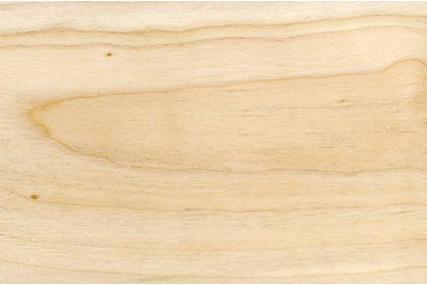Balsam poplar is a hardwood imported in small quantities and used for plywood, boxes, artificial limbs, wood wool, brake blocks and match splints.
East Asian Balsam Poplar, Korean Poplar, Canadian Poplar, Western Balsam, Black Cottonwood, Cottonwood, Populus spp., Populus koreana, Populus laurifolia, Populus maximowiczii, Populus simonii, Populus trichocarpa
Populus balsamifera
Balsam poplar is a hardwood native to Asia and North America, and small quantities are imported into Australia. It is used for match splints, plywood, artificial limbs, brake blocks, wood wool and boxes.
The heartwood of balsam poplar is pale brown, and the sapwood is white to cream and up to 80mm wide in fast-growing stems (about three growth rings). The grain is straight and the texture is fine but sometimes slightly uneven because of the harder latewood.
The woolly nature of balsam poplar makes it rather difficult to work unless tools are kept sharp. It glues and nails well. It is susceptible to termites and lyctid borer.
Shrinkage
| Very Low | Low | Medium | High | Very High | |
|---|---|---|---|---|---|
|
|
|
|
|||
|
Tangential :
|
4.30% | ||||
|
Radial :
|
1.80% | ||||
|
Unit Movement Tangential:
|
0.24% | ||||
|
Unit Movement Radial:
|
0.10% |
Strength Group
| Very High | High | Reasonably High | Medium High | Medium | Reasonably Low | Low | Very Low | |
|---|---|---|---|---|---|---|---|---|
| Unseasoned: | S1 | S2 | S3 | S4 | S5 | S6 | S7 | S8 |
|
|
||||||||
| Seasoned: | SD1 | SD2 | SD3 | SD4 | SD5 | SD6 | SD7 | SD8 |
Stress Grade
|
Structural No. 1 |
Structural No. 2 |
Structural No. 3 |
Structural No. 4 |
Structural No. 5 |
|
|---|---|---|---|---|---|
| Unseasoned: | F7 | F5 | F4 | ||
| Seasoned: |
Density per Standard
| Seasoned: | 410kg/m3 |
|---|---|
| Unseasoned: | kg/m3 |
Joint Group
| Very High | High | Reasonably High | Medium | Low | Very Low | |
|---|---|---|---|---|---|---|
| Unseasoned: | J1 | J2 | J3 | J4 | J5 | J6 |
| Seasoned: | JD1 | JD2 | JD3 | JD4 | JD5 | JD6 |
|
|
Colour
| White, yellow, pale straw to light brown | Pink to pink brown | Light to dark red | Brown, chocolate, mottled or streaky | |
|---|---|---|---|---|
|
|
||||
Mechanical Properties
|
Modulus of Rupture - Unseasoned:
|
34 |
|---|---|
|
Modulus of Rupture - Seasoned:
|
70 |
|
Modulus of Elasticity - Unseasoned:
|
7.9 |
|
Modulus of Elasticity - Seasoned:
|
11.5 |
|
Maximum Crushing Strength - Unseasoned:
|
14.6 |
|
Maximum Crushing Strength - Seasoned:
|
34.6 |
|
Impact - Unseasoned:
|
|
|
Impact - Seasoned:
|
|
|
Toughness - Unseasoned:
|
|
|
Toughness - Seasoned:
|
|
|
Hardness - Unseasoned:
|
|
|
Hardness - Seasoned:
|
1.6 |
Durability
| Low | Moderate | Reasonably High | High | |
|---|---|---|---|---|
| (0 - 5 yrs) | (5 - 15 yrs) | (15 - 25 yrs) | (more than 25 yrs) | |
|
In-Ground:
|
|
|||
| (0 - 7 yrs) | (7 - 15 yrs) | (15 - 40 yrs) | (More than 40 yrs) | |
|
Above ground:
|
||||
| (0 - 20 yrs, usually < 5) | (21 - 40 yrs) | (41 - 64 yrs) | (More than 60 yrs) | |
|
Marine Borer Resistance:
|
|
|
Lyctid Borer Susceptibility:
|
Susceptible |
|---|---|
| Lyctid Borer Susceptibility - Other: | |
|
Termite Resistance:
|
Not Resistant |
Fire Properties
| 1 - non-combustible | 2 - reasonably non-combustible | 3 - slightly combustible | 4 - combustible | |
|
Fire Properties Group Number: |
|
| Group Number - Other: | 3 (MDF or particleboard ≥12mm; veneer thickness 0.6-0.85mm) |
|---|---|
|
Average Specific Extinction Area:
|
<250 |
|
Bushfire Resistance:
|
Not Tested |
The heartwood of balsam poplar is pale brown, and the sapwood is white to cream and up to 80mm wide in fast-growing stems (about three growth rings). The texture is fine but sometimes slightly uneven because of the harder latewood, and the grain is straight.
Balsam poplar is used for plywood, boxes, artificial limbs, wood wool, brake blocks, match splints and boxes.
Asia

